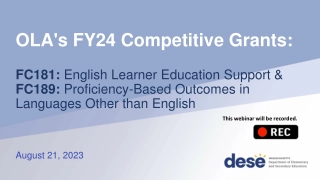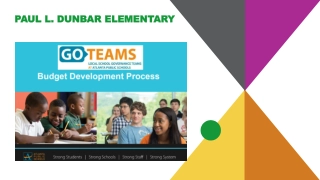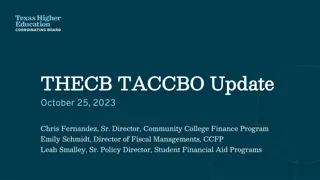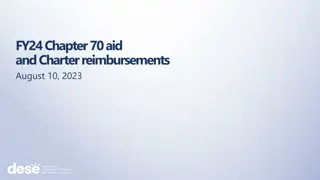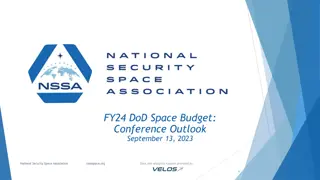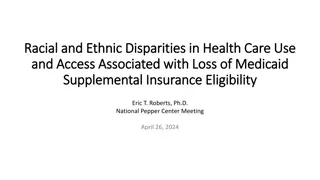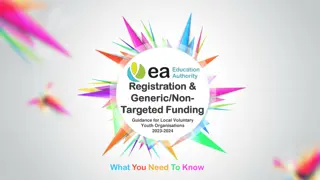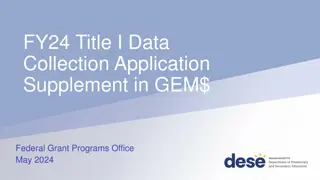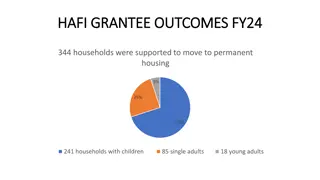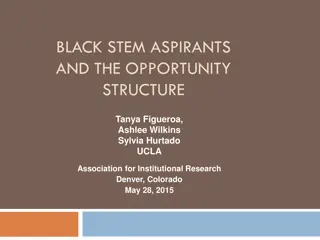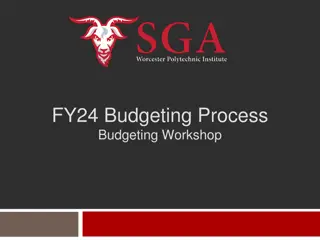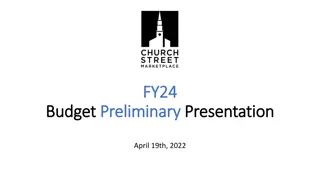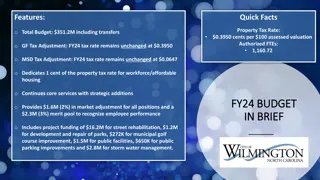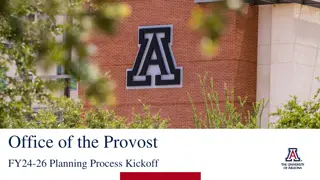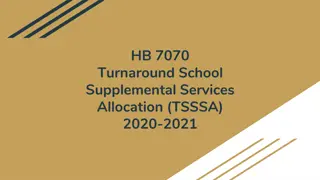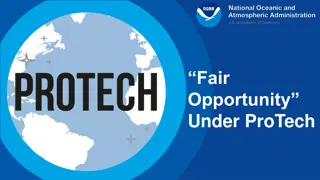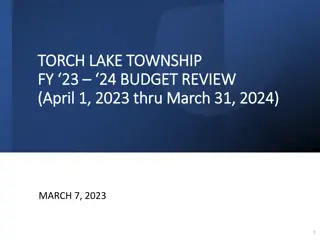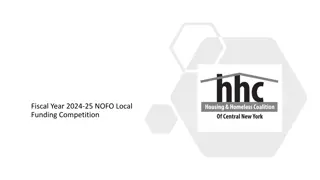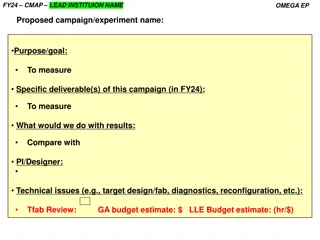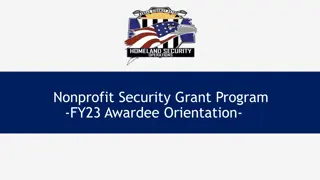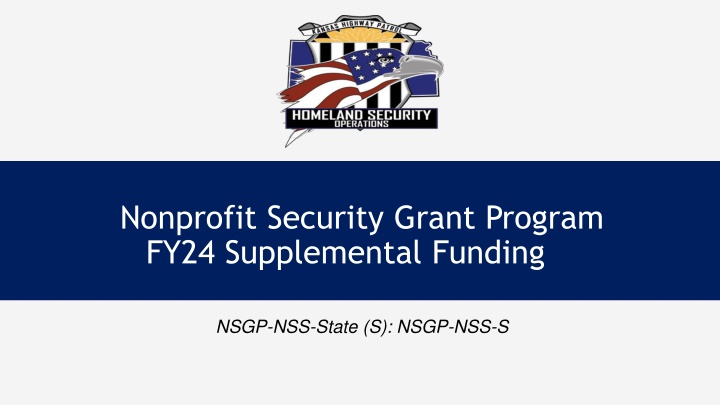
Enhancing Nonprofit Security: NSGP-NSS State Grant Program Overview
The NSGP-NSS State grant program provides funding to nonprofit organizations to enhance security measures against terrorist or extremist attacks. The focus is on improving physical and cybersecurity, facility hardening, and preparedness activities to safeguard lives and property. Priority areas include protecting soft targets and crowded places through various security enhancements. Apply for funding to strengthen security measures and contribute to national preparedness efforts.
Download Presentation

Please find below an Image/Link to download the presentation.
The content on the website is provided AS IS for your information and personal use only. It may not be sold, licensed, or shared on other websites without obtaining consent from the author. If you encounter any issues during the download, it is possible that the publisher has removed the file from their server.
You are allowed to download the files provided on this website for personal or commercial use, subject to the condition that they are used lawfully. All files are the property of their respective owners.
The content on the website is provided AS IS for your information and personal use only. It may not be sold, licensed, or shared on other websites without obtaining consent from the author.
E N D
Presentation Transcript
Nonprofit Security Grant Program FY24 Supplemental Funding NSGP-NSS-State (S): NSGP-NSS-S
NSGP-NSS-State (S): NSGP-NSS-S Overview The NSGP-NSS supplements one of three grant programs that support DHS/FEMA s focus on enhancing the ability of nonprofits, to prevent, protect against, prepare for, and respond to terrorist or other extremist attacks. These grants help to strengthen the nation s communities against potential terrorist or other extremist attacks. NSGP-NSS applicants include the State Administrative Agencies (SAA), and sub applicants include eligible nonprofit organizations and consortia of nonprofit organizations. DHS is focused on building a national culture of preparedness and protecting against terrorism and other threats to our national security. The threats to our Nation have evolved during the past two decades. We now face continuous cyber threats by sophisticated actors, threats to soft targets and crowded places, and threats from domestic violent extremists, who represent one of the most persistent threats to the nation today. Therefore, DHS/FEMA has identified one national priority area related to some of the most serious threats that recipients should address with their NSGP-NSS funds: enhancing the protection of soft targets/crowded places.
Goal, Objectives, and Priorities Goal: The NSGP-NSS will improve and increase the physical/cyber security and facility/target hardening of nonprofit organizations facilities at risk of a terrorist of other extremist attack, ultimately safeguarding the lives and property of the American people. All NSGP-NSS activities must be linked to enhancing the security and safety at the physical site of the nonprofit organization. Concurrently, the NSGP-NSS will integrate the preparedness activities of nonprofit organizations that are at risk of a terrorist or other extremist attack with broader state and local preparedness efforts. Objectives: Provide funding for physical and cybersecurity enhancements and other security- related activities to nonprofit organizations that are at risk of a terrorist or other extremist attack. Integrate the preparedness activities of nonprofit organizations with broader state and local preparedness efforts. Funding on Planning, Organizational, Equipment, Training, and Exercises (POETE) towards enhancing the protection of soft targets and crowded places, address and close capability gaps identified in individual nonprofit organization Vulnerability Assessments. Priorities: Given the evolving threat landscape, DHS/FEMA has evaluated the national risk profile and set priorities that help ensure appropriate allocation of scarce security dollars. In assessing the national risk profile, one area warrants the most concern under the NSGP-NSS: Enhancing the protection of soft targets/crowded places.
Allowable Priority Areas Enhancing the Protection of Soft Targets/Crowded Places Private contracted security guards, physical security enhancements, Closed circuit television (CCTV), security cameras, security screening equipment for people and baggage, access controls, fencing, gates, barriers, etc. Card readers, associated hardware/software, Cybersecurity enhancements, Risk-based cybersecurity planning and training, Improving cybersecurity of access control and identify verification systems, Improving cybersecurity of security technologies (e.g.,CCTV systems) Adoption of cybersecurity performance goals (CISA s Cross-Sector Cybersecurity Performance Goals) Planning Conduct or enhancement of security, risk assessments; Development of: Security plans and protocols, Emergency/contingency plans, Evacuation/shelter in place plans Training & Awareness Active shooter training, including integrating the needs of persons with disabilities, security training for employees, public awareness/preparedness campaigns Exercises Response exercises
Application facts In Kansas, eligible nonprofits can compete for $1,710,000 through the NSGP- Supplemental funding opportunity. Sub applicants may NOT apply to FEMA directly. Sub applicants must apply for NSGP-NSS through their SAA. The application packet will consist of a Risk Assessment, Investment Justification (IJ) and Mission Statement per site. Nonprofit organizations with one site may apply for up to $150,000 for that site. Nonprofit organizations (not applying as part of a consortium) with multiple sites may apply for up to $150,000 per site, for up to three sites per funding stream for a maximum of $450,000 for this funding opportunity. If a nonprofit sub applicant applies for multiple sites, it must submit one complete IJ and risk assessment per each site. Deadline to submit application packets to https://www.astrakansas.com/nsgp is 12/13/2024
Investment Justification (IJ) The IJ must describe each investment proposed for funding. The investments or projects described in the IJ must: 1. Be for the location(s)/physical address(es) (NOT P.O. Boxes) that the nonprofit occupies at the time of application 2. Address an identified risk, including threat and vulnerability, regardless of whether it is submitting for similar projects at multiple sites 3. Demonstrate the ability to provide enhancements consistent with the purpose of the program and guidance provided by DHS/FEMA 4. Be both feasible and effective at reducing the risks for which the project was designed 5. Be able to be fully completed within the three-year period of performance 6. Be consistent with all applicable requirements outlined in this NOFO and the Preparedness Grants Manual Sub applicants are required to self-identify with one of the following categories in the IJ as part of the application process: 1. Ideology-based/Spiritual/Religious (Houses of Worship, Educational Institutions, Medical Facilities, etc.) 2. Educational (secular) 3. Medical (secular) 4. Other
Sub Recipient Eligibility Nonprofit organizations eligible as sub applicants to the SAA are those organizations that are: 1. Described under section 501(c)(3) of the Internal Revenue Code of 1986 (IRC) and exempt from tax under section 501(a) of such code. This includes entities designated as private (e.g., private institutions of higher learning), as private colleges and universities can also be designated as 501c3 entities 2. Able to demonstrate, through the application, that the organization is at high risk of a terrorist or other extremist attack 3. For NSGP-NSS-UA, located within an FY 2024 UASI-designated high-risk urban area; or for NSGP-NSS-S, located outside of an FY 2024 UASI designated high-risk urban area https://www.irs.gov/charities-non-profits/charitable-organizations/exemption-requirements- 501c3-organizations Examples of eligible sub applicant organizations can include houses of worship, educational institutions, senior centers, community centers, day camps, medical facilities, and museums, among many others.
Consortium A consortium application is an opportunity for an eligible nonprofit organization to act as a lead and apply for funding on behalf of itself and any number of other eligible NSGP-NSS eligible nonprofit organizations. The lead nonprofit organization must fill out the Investment Justification to represent the collective of the consortium. Additionally, consortium applicants are required to fill out and submit a Consortium Workbook to their SAA which captures the necessary data for all participating consortium nonprofit organizations. All nonprofit organizations in the consortium application must be compliant with the NSGP-NSS eligibility requirements listed above. Nonprofit organizations may not apply both individually and as part of a consortium. The lead nonprofit organization and its partners must be the intended beneficiaries of the requested funding. The lead nonprofit organization shall not distribute grant-funded assets or provide grant-funded contractual services to non-compliant partner nonprofit organizations or other ineligible organizations. Note: If successful, the lead consortium member will accept the subaward on behalf of the consortium, implement the approved projects/contracts for all consortium member sites, and manage the subaward throughout the period of performance, to include ensuring that all terms and conditions of the subaward are met.
Consortium-Specific Application Requirements The lead nonprofit organization within the consortium must submit the same documents as part of the consortium application; however, the responses must represent the collective of the consortium. Each nonprofit organization with one site in the consortium may apply for up to $200,000 for that site. Consortium applications are limited to a maximum of $1,000,000 per consortium. The IJ must summarize the goal for the consortium investments proposed for funding. The investments or projects described in the IJ must: 1. Address an identified risk or risks, including threat and vulnerability, that will be mitigated by the consortium investment 2. Demonstrate the ability to provide enhancements consistent with the purpose of the program and guidance provided by DHS/FEMA 3. Be both feasible and effective at reducing the risks for which the project was designed 4. Be able to be fully completed within the three-year period of performance 5. Be consistent with all applicable requirements outlined in this NOFO and the Preparedness Grants Manual.
Consortium- Continued Nonprofit Organization Sub applicant Information, the lead nonprofit organization of the consortium must fill out the required fields based solely on the lead nonprofit organization s information. The lead nonprofit organization of the consortium must summarize the shared background information of all nonprofit organizations within the consortium. The lead nonprofit organization of the consortium must summarize the threats, vulnerabilities, and potential consequences facing all nonprofit organizations within the consortium. Additional space for further detail is available in the Consortium Workbook and more information on the Consortium Workbook can be found in Section D.10.c.II. In Part IV of the IJ, Facility Hardening, the lead nonprofit organization of the consortium must summarize how the proposed activities or investments of the consortium address the shared vulnerabilities identified in Part III. For Section IVB, the lead organization must input the total funding requested for all nonprofit organizations within the consortium under each AEL investment. In Part V of the IJ, Milestone, the lead nonprofit organization of the consortium must provide the key milestones from all nonprofit organizations within the consortium proposed activities.
Dual application opportunity in/out of UASI Sub applicants that have locations both within and outside of UASI designated high-risk urban areas can apply under both NSGP-NSS-UA and NSGP-NSS-S depending on the physical location of the facilities. In such cases, the sub applicant must submit separate applications for NSGP-NSS-UA and NSGP- NSS-S to the SAA (applicant) for funding consideration. SAA applicants and sub applicants must still adhere to the other restrictions and requirements set forth in this funding notice, including applying for a maximum of six locations total per nonprofit organization with no more than three locations in either NSGP-NSSUA or NSGP-NSS-S, and a maximum of $200,000 per location. Consortia may apply for a maximum of $1,000,000. The $200,000 per site maximum still applies for each individual nonprofit organization within the consortium. Consortium applicants will compete with other consortium applicants from across the country.
Dual application opportunity- continued If a sub applicant has a physical location within a defined Metropolitan Statistical Area, but the location is NOT within the bounds of how the UAWG defines the high-risk urban area footprint, then that location should apply under NSGP-NSS-S. Sub applicants should contact their SAAs to determine if their physical location falls within the UAWG-defined high-risk urban area footprint. Additionally, the final beneficiary of the NSGP-NSS grant award must be an eligible nonprofit organization and cannot be a for-profit/fundraising extension of a nonprofit organization or organizations. While these for-profit or fundraising extensions may be associated with the eligible nonprofit organization or organizations, NSGP-NSS funding cannot be used to benefit those extensions and therefore they will be considered ineligible applications. If the funding being sought is for the benefit of a for-profit/fundraising extension, then that would constitute an ineligible subaward since only nonprofit organizations and consortia of nonprofit organizations are eligible subrecipients. This is distinct from a contract under an award in which a nonprofit organization could seek the assistance of a for-profit/fundraising extension, but the purpose would be to benefit the nonprofit organization and not for the benefit of the for-profit/fundraising extension.
Scoring All organizations: Review the Scoring Matrix in Appendix A of the NOFO and work to follow those guidelines to help maximize your opportunity for points in each section of the IJ. No bonus points this round for new organizations. Multipliers by organization risk/type: By a factor of 4: Organizations facing heighted threat resulting from Israel-Hamas war (must be clear connection By a factor of 3: Ideology-based/spiritual/religious entities By a factor of 2: secular educational and medical institutions By a factor of 1: all other nonprofit organizations Located within a disadvantaged community, as defined by the Council on Environmental Quality s Climate and Economic Justice Screening Tool (CEJST) will have 10 bonus points added. Consortiums comprised of organizations within different categories and locations will be scored based on the type and location of the lead organization.
Scoring new Israel-Hamas multiplier Final Score will be multiplied by a factor of four for nonprofit organizations facing heightened threat resulting from the Israel-Hamas war (sub applicants must draw a clear connection between the heightened threat they face and the Israel-Hamas war in their project narratives to qualify for this multiplier). Any nonprofit organization that can demonstrate it faces heightened threat resulting from the Israel-Hamas war is eligible for this multiplier, regardless of the organization s purpose, mission, viewpoint, membership, or affiliations. Below are a few illustrative examples of scenarios that may qualify a nonprofit organization for this multiplier: A nonprofit organization that can demonstrate a clear threat of violence based on its actual or perceived views, positions, or advocacy related to aspects of the Israel-Hamas war. A private, secular university that faces threats from violent extremists that are associated with increased protest activity relating to the Israel-Hamas war, resulting in the need for additional public safety assets. An Arab organization that has been targeted, due to its ethnic affiliation, by violent extremists through online hate referencing the Israel-Hamas war. A Jewish day school that was vandalized by violent extremists seeking to commit attacks based on the Israel- Hamas war. An LGBTQI+ organization that faced violent protests during Pride events related to aspects of the Israel-Hamas war. A mosque that has received threats of violence based on the worldwide unrest because of the ongoing Israel- Hamas war. A Sikh organization where a violent extremist attempted to access a holiday celebration due to the organization s perceived position on the Israel-Hamas war.
Key Info Organizations and their sites apply through KS or MO? UASI: Sites with footprint in KS Metro counties of JO, WY, and LV: Apply through Missouri (see datacounts for links) State: Sites with footprint in all other Kansas counties: Apply through Kansas portal, Astra Kansas Help Sites and Application Portal Datacounts.net/nsgp: Application information and resources Astra: Subscribe for email announcements and submit applications Subscribe for announcements and updates: https://nsgp.astrakansas.com/nsgp Register as a user to submit your application: https://nsgp.astrakansas.com/users/new Login and submit/upload your application: https://nsgp.astrakansas.com/ What to Submit (upload on Astra): 1. Mission Statement 2. Vulnerability/Risk Assessment 3. Investment Justification 4. For Consortiums only: Consortium Workbook Submission Deadline: December 13th
CONTACTS Captain Amber Harrington K-265 KHP - Homeland Security/Emergency Operations 122 SW 7th Street, Topeka, KS 66603-3847 (785) 296-6800 Amber.harrington@ks.gov Melissa McCoy Program Consultant I KHP - Homeland Security / Emergency Operations 122 SW 7th Street, Topeka, KS 66603-3847 (785) 368-7187 (Office) (785) 925-2148 (Cell) Melissa.McCoy@ks.gov Lieutenant Edna Cordner K-299 KHP - Homeland Security / Emergency Operations 122 SW 7th Street, Topeka, KS 66603-3847 (785) 207-0423 (Cell) Edna.cordner@ks.gov Melanie Lawrence Program Consultant II KHP - Homeland Security/Emergency Operations 122 SW 7th Street, Topeka, KS 66603-3847 (785) 296-6654 (Office) (785) 256-5191 (Cell) Melanie.Lawrence@ks.gov Connie Satzler EnVisage Consulting Web portal and IJ assistance 6847 Anderson Ave. Manhattan, KS 66503 Phone: (785) 410-0410 csatzler@kansas.net Http://www.datacounts.net/nsgp
Questions? NSGP.KHP@KS.GOV

